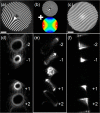Shaping of Electron Beams Using Sculpted Thin Films
- PMID: 34938823
- PMCID: PMC8679091
- DOI: 10.1021/acsphotonics.1c00951
Shaping of Electron Beams Using Sculpted Thin Films
Abstract
Electron beam shaping by sculpted thin films relies on electron-matter interactions and the wave nature of electrons. It can be used to study physical phenomena of special electron beams and to develop technological applications in electron microscopy that offer new and improved measurement techniques and increased resolution in different imaging modes. In this Perspective, we review recent applications of sculpted thin films for electron orbital angular momentum sorting, improvements in phase contrast transmission electron microscopy, and aberration correction. For the latter, we also present new results of our work toward correction of the spherical aberration of Lorentz scanning transmission electron microscopes and suggest a method to correct chromatic aberration using thin films. This review provides practical insight for researchers in the field and motivates future progress in electron microscopy.
© 2021 The Authors. Published by American Chemical Society.
Conflict of interest statement
The authors declare no competing financial interest.
Figures






References
-
- Haider M.; Rose H.; Uhlemann S.; Schwan E.; Kabius B.; Urban K. A Spherical-Aberration-Corrected 200 KV Transmission Electron Microscope. Ultramicroscopy 1998, 75, 53.10.1016/S0304-3991(98)00048-5. - DOI
Publication types
LinkOut - more resources
Full Text Sources
